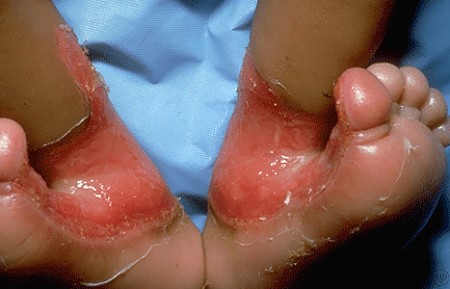
Table of Contents
What Is Epidermolysis Bullosa?
Epidermolysis bullosa (EB) is a group of rare genetic disorders characterized by extremely fragile skin and mucous membrane, resulting in easy blistering and erosions following minor trauma. There are four main types of EB based on the level of blistering, namely simplex, junctional, dystrophic and Kindler syndrome. Diagnosis is made with clinical manifestations and skin biopsy or genetic testing. The cause of epidermolysis bullosa is genetic mutations with at least 20 genes involved, resulting in defective proteins in the skin. The human skin has two layers: epidermis and dermis. In normal healthy skin, the two layers are anchored together by proteins. However, individuals with EB have defective protein anchors, resulting in extremely fragile skin. Even minor friction like rubbing or pressing can shear off and separate the two layers, forming painful blisters. The pain is comparable to a 3rd-degree burn. Moreover, the constant shearing and trauma of the skin increase the risk of developing skin cancer.
What are the symptoms and complications of EB?
EB is usually evident at birth but the severity of symptoms varies from mild to severe. Those with mild EB may not have symptoms until they start crawling and walking. The severe ones can have painful blisters and erosions just from minor bumps and friction from clothing. Some forms of EB have gastrointestinal manifestations like oesophagal strictures and reflux, anal fissure, rectal tears and constipation due to recurrent blistering on the mucous membrane causing scarring. Other problems include urinary tract problems, nail dystrophy, corneal blisters and oral blisters. Complications of EB are malnutrition, anaemia, infection and skin cancer.
What Is The Treatment For EB?
Presently, there is no cure for EB. Treatment plans involve long term wound care, pain management, infection control and complications prevention.
What Is The Life Expectancy Of EB?
Prognosis of EB is based on the severity and types. Epidermolysis bullosa simplex (EBS) is the most common type, consisting of about 70% of all cases. In EBS, the blisters are formed on the epidermis (outermost) layer of the skin. Hence the blisters tend to heal without leaving scars and less likely to develop complications from scarring. The milder form of EBS generally has a good outcome with some cases improving with age. Other forms of EBS are more severe and risk early infant death.
Dystrophic epidermolysis bullosa (DEB) accounts for 25% and the blistering occurs in the upper layer of the dermis. Most individuals with DEB have a normal life expectancy but generally causes more long-term complications than EBS. The blisters continue into adulthood, resulting in scars formation and deformity. Generalised DEB, another form of DEB, may lead to chronic kidney failure. Individuals with DEB also have a higher risk of developing squamous cell carcinoma, a type of fatal skin cancer.
Junctional epidermolysis bullosa (JEB) is the rarest with only 5%. As the name implies, the blisters occur in the junction between the epidermis and dermis layer. The life expectancy of individuals with JEB is poor. Nearly half of them do not live past the first year of life, and many die before they reach 5 years old. Few individuals with JEB are able to survive into adulthood.
Lastly, Kindler syndrome is a distinct type of EB. In the majority of the cases, life expectancy is normal. At birth, skin blistering is more prominent on extremities. But the blisters tend to regress and are rare in adulthood. However, other symptoms come with age, such as photosensitivity, sunlight-induced blisters, gum bleeding and periodontitis. Another frequent feature is digital webbing. Adults with Kindler syndrome are also more prone to squamous cell carcinoma, with studies showing 70% of them are older than 45 years old.
